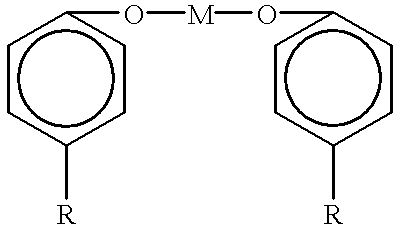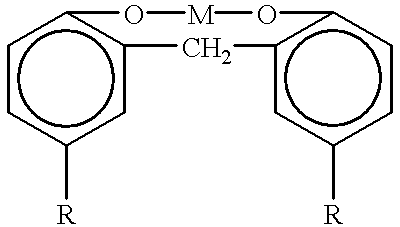Lubricants containing molybdenum compounds, phenates and diarylamines
a technology of molybdenum compounds and diarylamines, which is applied in the field of lubricants, can solve the problems of not being able to suggest a three-component mixture substantially free of reactive sulfur, reference fails to teach substantially molybdenum compounds, and commercial sulfur-containing molybdenum compounds are considerably more expensive than sulfur-free molybdenum compounds
- Summary
- Abstract
- Description
- Claims
- Application Information
AI Technical Summary
Benefits of technology
Problems solved by technology
Method used
Image
Examples
example 2
This experiment was conducted to evaluate the three-component additive system of the invention against a diphenylamine / calcium phenate additive system in the CMOT and the Caterpillar 1M-PC engine. The 1M-PC test method is designed to relate to high speed, supercharged diesel engine operation, and, in particular, to the detergency characteristics and anti-wear properties of diesel crankcase lubricating oils. This test uses a single-cylinder supercharged diesel engine to evaluate ring sticking, ring and cylinder wear and piston deposits. Prior to each test run, the power section of the engine (excluding piston assembly) was completely disassembled, solvent cleaned, measured, and rebuilt in strict accordance with furnished specifications. A new piston, piston ring assembly and cylinder liner were installed prior to each test. The engine crankcase was solvent cleaned and worn or defective parts were replaced. The test stand was equipped with appropriate accessories for controlling speed...
example 3
This experiment was conducted to further characterize the inventive three-component additive package against additive packages outside the scope of the present invention using the 1M-PC test. Table 5 sets forth the composition of Oils #17 and #18 that were used in Example 2, and Oils #19 and #20 used in this Example.
The 1M-PC test as described in Example 2 was used to test Oils #17-20. The results are presented in Table 6.
The data in Table 6 clearly support the innovative three-component additive system (Oils #18 and #19) as being highly effective in reducing the amount of deposit formation. Oil #18 was also evaluated in the Cummins 8.3 L Natural Gas Engine. The Cummins Natural Gas Engine Test utilizes a turbocharged, in-line 6 cylinder, overhead valve configuration with 8.3 L displacement. This design is representative of many modern NG engines. The engine features electronic control of air / fuel ratio and spark timing. This test is designed to evaluate oil performance in terms of t...
example 4
Four additional oils were prepared similar to those described in Table 5, except the levels of non-diarylamine antioxidant, diarylamine, calcium phenate and molybdenum compound were as set forth in Table 9.
Oils #21-24 were subjected to the Panel Coker Test. The Panel Coker Test is a procedure for determining the tendency of oils to form solid decomposition products when in contact with surfaces at elevated temperatures. The test used a Falex Panel Coking Test Apparatus. The Falex apparatus is designed to perform Federal Test Standard 791 B, Method 3462. The results for this test are set forth in Table 10.
The inventive Oils #22 and #24 significantly outperformed the control Oils #21 and #23 which were respectively identical except that the controls contained no molybdenum compound. This test also supports the inventor's findings that the three-component additive package exhibits synergistic activity in protecting a lubricating oil from thermal and oxidative degradation. From the resu...
PUM
| Property | Measurement | Unit |
|---|---|---|
| weight ratio | aaaaa | aaaaa |
| weight ratio | aaaaa | aaaaa |
| weight percent | aaaaa | aaaaa |
Abstract
Description
Claims
Application Information
 Login to View More
Login to View More - R&D
- Intellectual Property
- Life Sciences
- Materials
- Tech Scout
- Unparalleled Data Quality
- Higher Quality Content
- 60% Fewer Hallucinations
Browse by: Latest US Patents, China's latest patents, Technical Efficacy Thesaurus, Application Domain, Technology Topic, Popular Technical Reports.
© 2025 PatSnap. All rights reserved.Legal|Privacy policy|Modern Slavery Act Transparency Statement|Sitemap|About US| Contact US: help@patsnap.com



